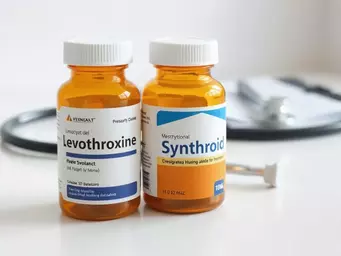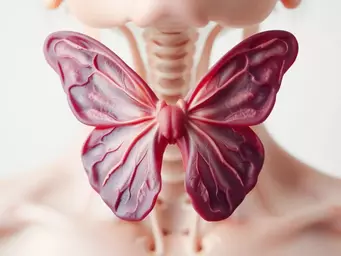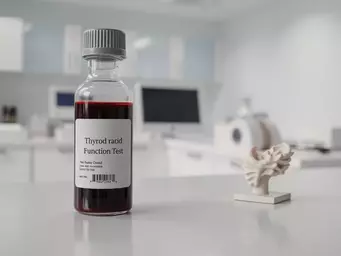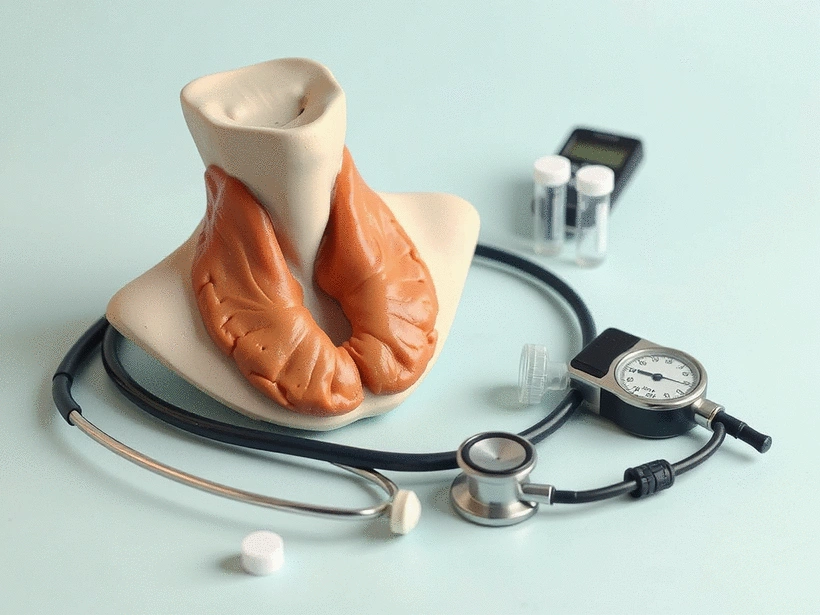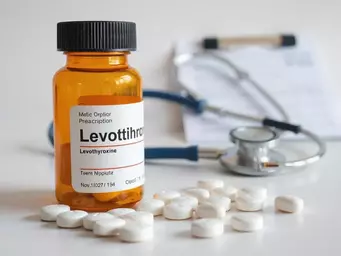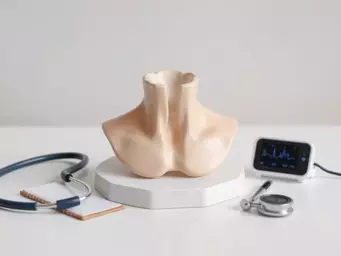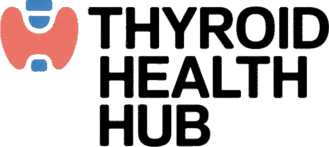Thyroid Anatomy and Metabolism Basics
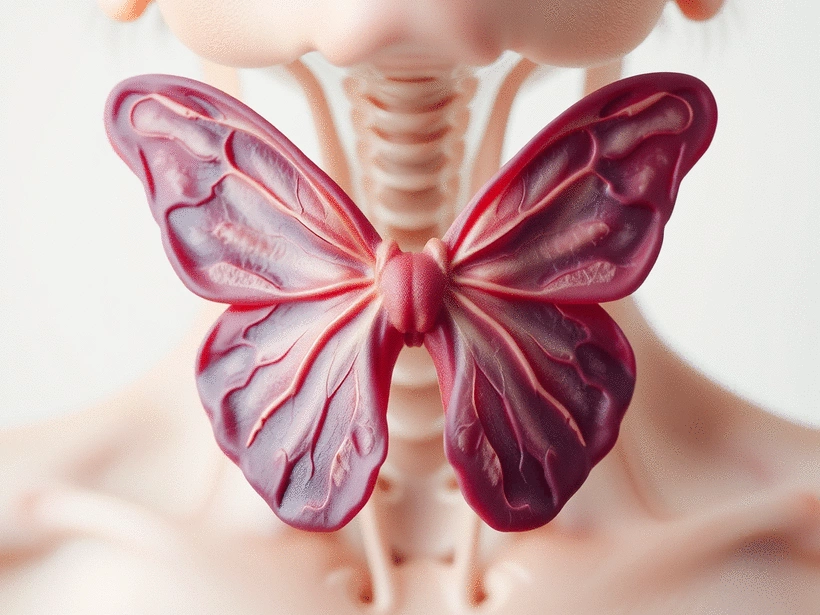
Consider this: Did you know that understanding the thyroid gland can have a profound impact on your overall health? This small but mighty gland influences everything from your energy levels to your metabolism. As we explore its anatomy and function, you'll discover why it's essential to prioritize thyroid health.
What You Will Learn
- The thyroid gland is located in the front of the neck and plays a crucial role in regulating metabolism and energy levels.
- It consists of follicles that produce T3 and T4 hormones, essential for metabolic function, and C cells that help regulate calcium levels.
- Iodine is vital for thyroid hormone production, highlighting the importance of a balanced diet for optimal thyroid health.
- Common thyroid conditions, such as goiter and nodules, can significantly affect health and should be monitored regularly.
Thyroid Gland: Key Components and Functions
The thyroid gland, a crucial part of the endocrine system, is made up of two primary cell types, each with distinct functions vital for regulating metabolism and calcium levels in the body.
Follicles (The Hormone Producers)
Synthesize and store T3 and T4 hormones.
Essential for regulating metabolism, growth, and energy levels.
C Cells (The Calcium Regulators)
Produce calcitonin hormone.
Crucial for regulating calcium levels and maintaining bone health.
Understanding the Thyroid Gland: Location and Structure
Welcome to our journey into the fascinating world of the thyroid gland! Located at the front of your neck, this butterfly-shaped gland plays a critical role in your overall health. Understanding its structure and function is essential for grasping how it influences numerous bodily processes, especially metabolism. So, let’s break it down together!
The thyroid gland is strategically positioned just below your Adam's apple, wrapping around the trachea. Its primary job? To produce hormones that regulate various aspects of your metabolism, growth, and energy levels. But what exactly makes up this vital gland? Let’s explore its key components!
The Anatomy of the Thyroid Gland: Key Components
The thyroid gland consists primarily of two types of cells: follicles and C cells. Follicles are small spherical structures that synthesize and store thyroid hormones, while C cells produce calcitonin, which helps regulate calcium levels in the body. Together, these components ensure your body functions optimally.
- Follicles: Responsible for producing T3 and T4 hormones, essential for regulating metabolism.
- C Cells: Produce calcitonin, playing a crucial role in calcium homeostasis.
By understanding the anatomy of the thyroid, you can appreciate its multifaceted role in maintaining balance within your body. It’s more than just a gland; it’s a core player in your endocrine system!
Follicles and C Cells: Functional Insights
Follicles are lined with cells that absorb iodine, a vital element for thyroid hormone production. For a deeper understanding of thyroid hormone synthesis, you can refer to authoritative sources like the National Center for Biotechnology Information (NCBI). When you think about it, your diet affects your thyroid health significantly! The C cells, on the other hand, respond to calcium levels in your blood, ensuring that your bones remain healthy and strong. This intricate interplay highlights why maintaining a balanced diet is essential for thyroid function.
Connection to the Endocrine System: How the Thyroid Fits In
The thyroid gland is an integral part of the endocrine system, working in concert with other glands like the pituitary and hypothalamus. It receives signals from the pituitary gland, which secretes Thyroid Stimulating Hormone (TSH) to regulate its activity. This connection ensures that your thyroid can respond effectively to your body’s needs, whether that means ramping up hormone production during a growth spurt or slowing it down when energy needs decrease. The coordinated function of these glands is well-documented in resources such as this overview of the endocrine system from the NCBI.
Common Conditions Related to the Thyroid Gland: Goiter and Nodules
Now that we’ve laid the groundwork on the thyroid’s anatomy, it’s crucial to explore some common conditions that can affect its health. Two prevalent issues are goiters and thyroid nodules.

- Goiter: An enlargement of the thyroid gland, often resulting from iodine deficiency or autoimmune conditions.
- Thyroid Nodules: These are lumps in the thyroid that can be benign or malignant, requiring monitoring and sometimes treatment.
Understanding these conditions can help you recognize symptoms early on. Have you noticed any changes in your neck or unusual symptoms? Always consult with a healthcare professional for proper assessment and management!
Thyroid Hormones: Production and Types
Let’s dive into the hormones produced by the thyroid and how they impact your health.
Pro Tip
Did you know? Regularly incorporating iodine-rich foods, such as seaweed, fish, and dairy products, can significantly support your thyroid health? Ensuring you get enough iodine is crucial for the synthesis of thyroid hormones, which helps maintain your metabolism and overall energy levels. The importance of iodine in thyroid function is further elaborated in this study on iodine and thyroid disease.
Recap of the Thyroid Gland's Role in Metabolism
As we wrap up our exploration of the thyroid gland, it’s essential to reflect on its vital role in our metabolism. This butterfly-shaped gland, located in the front of your neck, is a powerhouse that regulates numerous bodily functions. From energy levels to weight management, the thyroid gland significantly influences how our bodies perform on a daily basis.
We’ve covered a lot, but here are the key takeaways: the thyroid is responsible for producing crucial hormones that affect not just our metabolism, but also growth, development, and overall health. Understanding these functions can empower you to take charge of your thyroid health and recognize when something might be off.
Summary of Key Points: Anatomy, Function, and Importance
- The thyroid gland is an integral part of the endocrine system.
- It produces hormones like T3 and T4, essential for regulating metabolism.
- Iodine is crucial for hormone synthesis, emphasizing the need for a balanced diet.
- Regular check-ups can help monitor thyroid function and prevent disorders.
By grasping these fundamental aspects, you’re better equipped to understand your body’s signals. Have you ever wondered how your thyroid health impacts your energy? It's a pivotal connection that influences how you feel every day!
Frequently Asked Questions (FAQs)
- What is the primary function of the thyroid gland?
- The thyroid gland's primary function is to produce hormones (T3 and T4) that regulate metabolism, growth, and energy levels throughout the body.
- Where is the thyroid gland located?
- The thyroid gland is located at the front of the neck, just below the Adam's apple, wrapping around the trachea.
- What are the two main types of cells in the thyroid gland and their roles?
- The two main types are follicles, which produce T3 and T4 hormones for metabolism, and C cells, which produce calcitonin to regulate calcium levels and bone health.
- Why is iodine important for thyroid health?
- Iodine is a vital element absorbed by follicles and is necessary for the synthesis of thyroid hormones (T3 and T4). A balanced diet with sufficient iodine is crucial for optimal thyroid function.
- What are common thyroid conditions mentioned in the article?
- The article mentions goiter (an enlargement of the thyroid gland) and thyroid nodules (lumps in the thyroid) as common conditions that may require monitoring or treatment.
Encouragement for Regular Health Check-ups and Awareness
At Thyroid Health Hub, we advocate for proactive health management. Regular health check-ups are not just a recommendation; they are vital for early detection of any thyroid issues. Routine blood tests can help monitor your hormone levels, ensuring that any imbalances are addressed promptly.

Make it a goal to stay informed about your thyroid health. Awareness is empowering! A simple conversation with your healthcare provider can lead to better understanding and management of your thyroid function. Remember, being proactive can lead to a healthier and more energetic life!
Further Reading and Resources
Links to Trustworthy Sources for More In-Depth Information
For those looking to delve deeper into the subject of thyroid health, I encourage you to explore these reliable resources:
- American Thyroid Association - Offers comprehensive guides and research updates.
- National Institutes of Health (NIH) - A repository of medical literature and studies.
- Mayo Clinic - Provides patient-friendly information on thyroid conditions.
Dive into these resources for a richer understanding of your thyroid health! Each link leads to valuable insights that can further guide your health journey.
Invitation for Comments and Questions from Readers
Your experiences and questions matter! I invite you to share your thoughts in the comments section below. Whether you have a personal story, a question about thyroid health, or need clarification on a topic we’ve discussed, I’m here to help. Engaging with our community helps everyone learn and grow together!
Let’s foster a supportive environment where knowledge is shared and awareness is raised. I look forward to hearing from you!
Recap of Key Points
Here is a quick recap of the important points discussed in the article:
- The thyroid gland is a crucial part of the endocrine system, located in the front of the neck.
- It produces essential hormones like T3 and T4, which regulate metabolism, growth, and energy levels.
- Iodine intake is vital for hormone synthesis, highlighting the importance of a balanced diet.
- Regular health check-ups are crucial for monitoring thyroid function and preventing disorders like goiter and nodules.
